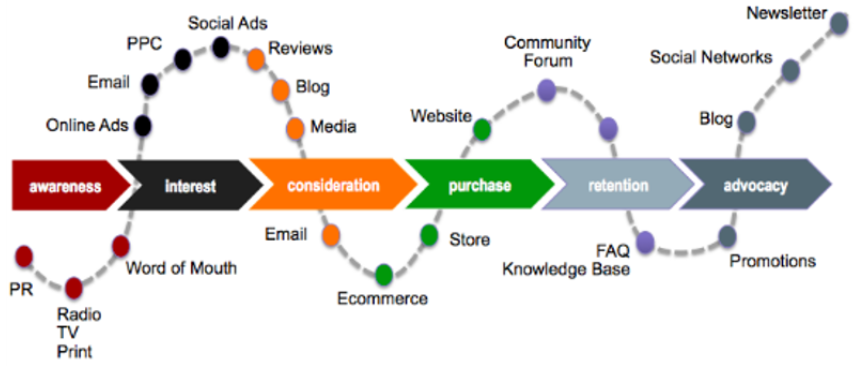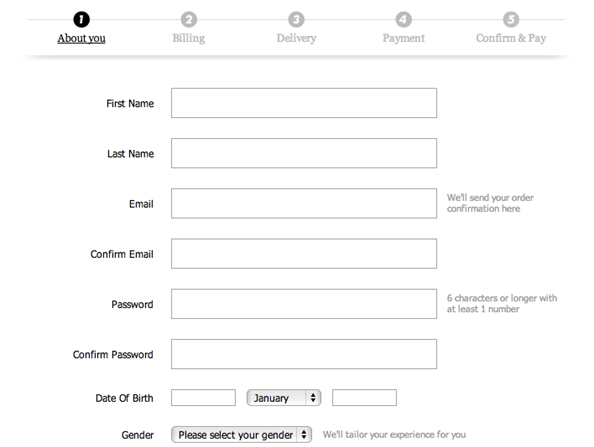“Are we nearly there yet?” is the dreaded question when travelling with young children. It is likely to first be asked a few minutes into the journey. Unless you are very lucky or have incredibly creative parenting skills it will then continue to be asked at random – yet increasingly frequent – intervals thereafter.
Annoying though it is, the children do have a point! The point of a journey is to reach a destination and it does help if you understand the context about what that destination is and how much progress are you making towards it.
“Are we nearly there yet?” is the very question that marketers and digital marketing agencies should be asking themselves about the customer journey. How near are we to understanding what that journey is and how we can improve it?

The customer journey is a complex one. The image below shows many of its stages and how they interrelate. It is taken from research by Econsultancy and Emarsys – around 1,000 digital marketers and ecommerce professionals from companies and digital marketing agencies in Asia Pacific were surveyed between August and October 2016.

The research found that companies and agencies had differing levels of confidence about how well they understood the customer journey. Whilst very few respondents (3%) described their knowledge as non-existent, a larger proportion (34%) classed themselves as “beginners”.
At the other end of the spectrum, 17% reckoned they were “accomplished”, leaving the majority group – 46% classing themselves as “intermediate”.
So, on a positive note, there are more marketers out there that think they are getting to grips with the customer journey than those that don’t. But where are these marketers getting stuck? What are the issues stopping those with intermediate understanding becoming accomplished, and how can the beginners join the ranks of the intermediate?
The research identified five main steps in understanding the customer journey:
1. Having a solid business case: making sure that everyone in the organisation is on board with the concept
2. Identifying the channels: as can be seen from the above image, potential channels are many and varied, and need to be identified as accurately as possible up front in order to stand a chance of success.
3. Gathering data: how can customer usage of each channel – and its effectiveness – be accurately measured
4. Joining the dots: once channels are identified and data gathered, it is then a case of ”joining the dots” to see how customers can be tracked as they progress through the channels
5. Measuring effectiveness: The above process is iterative and ongoing: it needs to be proved to be effective in order to justify the business case that was made in the first place.
The research also established that the main stage where marketers get stuck is Step 4 – Joining the dots. Issues arise when trying to put together all pieces of the jigsaw. Some of the major issues for marketers at this stage are:
- acquiring customer data, from both online and offline sources
- accessing internal data that may be embedded in department data silos
- not having sufficiently up to date and competent technology to analyse the data that they do have

Issues such as these can cause major roadblocks in developing an advanced understanding of the customer journey. So what can be done?/
Frustrating though it may be, Rome wasn’t built in a day, as they say. The only real solution is to go back to basics again at every level of the organisation. Further cultural change may be required to make the company more customer-facing and help everyone to understand the priority of the customer journey.
Without the capturing of hearts and minds in the leadership of the organisation you cannot completely success in this mission. So working to change the culture of the organisation has to be the first priority.
Within the context of that there are three other things that can be done:
- review the suitability of your IT solutions for effectively capturing data across touchpoints, and recommend improvements/replacements where needed;
- continue to build up skills and expertise – and interest – in analysing customer data;
- ensure that you prove ROI to the business so that it is seen to be worthwhile./

No mean feat but it will be worth it in the end! The more you can understand your customers and improve their experience, the happier they will be with your products and services, and this will be reflected in all aspects of your business including an improved bottom-line.

